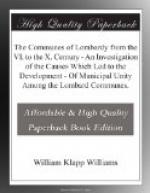The next step in the growth of the episcopal power, and the most important of all, is the progress from exemption to privilege, to jurisdiction; and occurs after the return of the kingship of Italy to the hands of native kings.[96] It means the full development of the bishop into the temporal ruler, and as such belongs properly to the history of the tenth century, and consequently is beyond the limits of the present paper.
We have now considered individually and separately, in the course of their development, the different elements which, when combined and modified by the various changes described, contributed to form the solid foundation upon which the fabric of the future independent life of the cities was to be built. We have been dealing exclusively with institutions, and the manner in which their growth has been accomplished. For it is in the institutional life of a people, and in the change and development it undergoes, that are to be found those elements which form the basis for all future changes, whether simply in the form of its government or in the structure of its social system. If once a clear picture is gained of the structural parts which form the institutional framework of any particular development, and a truthful presentation of these forming principles is proved and established, a detailed account of the material expression of them is a matter of secondary importance.
I have not, in this paper, attempted to describe the actual condition of any particular municipality, or even presented a picture which could represent the material existence of the cities as a whole. Such a picture would only be a necessary part of a study of institutions when the city itself was the unit to be investigated, and not of one whose chief object is to prove that the city as such had no constitutional existence, but simply formed a part of another institutional unit. When we reach a period in which the city stands out as an object of study in itself, and when we do not have to trace its history only by learning that of other institutions which included and overshadowed it, then the practical life of the people within its walls becomes of the greatest importance, even to the smallest detail of civic law or city custom; and then, and not till then, begins what could properly be called a study of municipal institutions.
During the three centuries that we have been investigating, the study of the Italian municipalities has been, as we have seen, but the study of other institutions of which the municipality formed only a part. No attempt has been made to do more than prove the origin and trace the earliest development of those principles, which in their maturity were to gain for the municipal unit that position where the study of its own structure would become an object of interest, entirely apart and distinct from any of its surroundings. It has been shown that the city did not inherit any such position from its immediate predecessor the Roman




